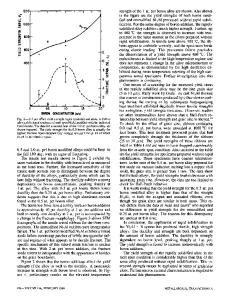Ductility and Fracture Behavior of Single Crystalline Ni 3 Al with Boron Additions
- PDF / 1,485,949 Bytes
- 6 Pages / 420.48 x 639 pts Page_size
- 19 Downloads / 394 Views
DUCTILITY AND FRACTURE BEHAVIOR OF SINGLE CRYSTALLINE Ni 3 AL WITH BORON ADDITIONS. F. E. HEREDIA and D. P. POPE. University of Pennsylvania, Department of Materials 3231 Walnut Street, Philadelphia, Pa. 19104.
Science
and
Engineering,
ABSTRACT Low and high temperature tensile tests were performed on single crystals of pure Ni 3 AI and Ni 3 AI+B in order to determine the effect of B additions on the ductility and fracture behavior. Tests were carried out in air at a constant strain rate of 1.3 x 10-3 s-1. The orientations tested were [001] for which the yield stress in tension is always greater than in compression, and those for which the tension/compression asymmetry is zero ([T=C]) for each particular composition. At room temperature, the results show a positive effect of B additions on both the fracture stress and on the ductility. The ductility at 800K appears to decrease monotonically with B additions. The largest ductilities are found for [T=C] at room temperature where an improvement of about 26% (resolved strain) for an addition of 0.2 at% B was obtained. However, the most dramatic increase in ductility occurs for the (0011 oriented samples at room temperature where a 55% improvement was measured over that of pure Ni 3 AI. Fracture surfaces show a combination of massive slip, some cleavage, and heavily dimpled areas. These observations show that B additions not only increase the ductility of polycrystalline Ni 3 Al, as has been previously observed by many investigators, but also that of the already-ductile single crystalline material, indicating that a "bulk effect" should be added to the grain boundary strengthening effect of B when explaining the improvement in ductility of polycrystalline Ni 3 AI due to B additions.
INTRODUCTION Ni 3 A1 single crystals have been known to be quite ductile when deformed at room temperature since Copley and Kear reported their work in 1967 [1]. On the other hand, polycrystalline Ni 3 AI is found to be brittle at room and elevated temperatures. Since Aoki and Izumi [2] reported in 1979 an improvement in the ductility of polycrystalline Ni 3 Al when boron is added, a great deal of research has been carried out trying to determine the mechanism by which boron increases the ductility [3]. The lack of ductility of B-free Ni 3 AI has been attributed to intrinsically weak grain boundaries [4,5]. Trying to rationalize the positive effect of boron some researchers see boron improving the grain boundary adhesive strength [6,7], and others have concluded that boron additions facilitate slip propagation across the grain boundary, reducing the stress concentration at the boundaries [8,9]. To the best of our knowledge, measurements of the effects of boron on Ni 3 AI single crystals have not yet been reported, probably due to the fact that single crystalline material is already ductile. Nevertheless, it is possible that some of the ductility improvement observed in polycrystalline Ni 3 AI may be related to a bulk effect, and since we had some crystals with varying B contents, we deci
Data Loading...











